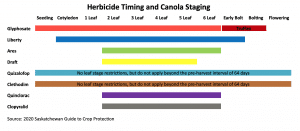It can happen that the first herbicide application of the year is delayed to well past crop establishment. For canola fields that have not been sprayed, effective weed control may come down to one herbicide application – so make that application count.
Assess the situation in each field. Answers to the following questions can determine the course of action, including rates, tank mixes and more: How many weeds are present? How big are they? What species are they? What is the crop stage? What is the crop stage relative to the weed stage?
If weed population is higher than the crop population, and weeds are more advanced or at the same stage as the crop, the highest available rate of herbicide may be required to provide the best weed control.
Know the weeds present, and know the herbicide rate required to truly control those weeds.
If you have a lot of grassy weeds in a Liberty Link canola field, you will want to tank mix clethodim with the Liberty (glufosinate) at a rate suited to the infestation level. Or, if it’s a Clearfield or Falco crop, you may want to spray grassy weed herbicide early and save the partner broadleaf herbicide for a second pass. Those partner products can only be sprayed once per season. More details for each system.
If cleavers are a problem, a tank mix with quinclorac may be recommended. When using a tank mix, pay attention to the mixing order. It often changes based on the products in the mix. (For evidence of this, see the Liberty tech sheet linked at the very bottom of this article.) This is often critically important to avoid clumping and other major issues.
And finally, if the crop is moving toward the end of its herbicide spray window, it’s most likely that the crop will be sprayed only once. Under such circumstances, maximize herbicide efficacy by putting together an effective tank mix, choosing the higher herbicide application rate, and spraying under good conditions. (See the graph below for window of application for each product, and the table for rates and other details.)
In-crop herbicides for use in canola
Other weed factors this week
Rain delays and rainfastness. If the field was sprayed two hours ago and it has started to rain, will the herbicide work? Rainfast ratings will provide clues. If, for example, you applied a tank mix of clethodim (rainfast one hour) and Liberty/glufosinate (rainfast four hours), the grass weed control from the clethodim should be satisfactory. Glufosinate efficacy may be reduced, but it may provide enough control to get the job done. Be patient though. Glufosinate will take a few days to show activity. While you can see some yellowing in a few days, it takes a week or so to begin to gauge weed control. If rain is in the forecast and you’re wondering whether to spray, make a decision based on the longest rainfastness time among the products in a tank mix.
Weather delays and spray tank issues. Don’t leave the sprayer full of anything. Spray it out – emptying the tank and the booms. Then rinse it. Liberty 150SN formulation is more than 50 per cent genapol, a surfactant or soap that can clean and lift residues (including Group 2 residues) off tank walls, inside hoses, on nozzle screens and/or filters. Liberty is a great Group-2 scrubber. When Liberty sits in a sprayer tank and boom overnight, the Group-2 residue it scrubs from the sprayer tank and plumbing could cause damage to the canola crop. Sprayer clean-out tips.
Spraying in the wind. Low-drift nozzles and lowering spray pressure are good ways to reduce drift risk when wind conditions are at the top end of the acceptable range (20 km/h). More tips for spraying in the wind. Spray tank additives to reduce fines (Interlock, LI-700) can also reduce (but not eliminate) driftable droplets. Can I spray at night when winds are more calm?
Post-application scouting. Consider how long each herbicide takes to show control symptoms. Begin scouting after that period has elapsed and give the herbicide application an evaluation based on efficacy and escapes. If escapes show no clear pattern (like a sprayer miss) consider having them checked for herbicide resistance. If overall efficacy was less than expected, check spray-day notes on temperature, moisture, rainfall, rates, water rates, etc., and look for clues to what might be done next time to improve results. Maybe the product just isn’t that strong on the weeds in question. If you see injury to canola seedlings, look for patterns in the field and check your sprayer notes, paying attention to previous tanks, cleaning and delays.

